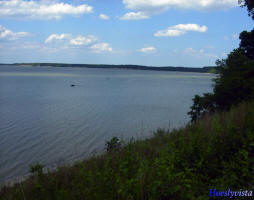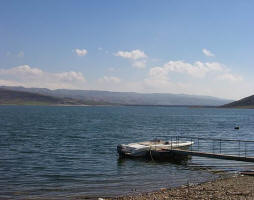 Fossil Seawater affects Coastal Aquifer
Fossil Seawater affects Coastal Aquifer
Rising
salinity in the primary source for desalinated tap water in
Vengosh, professor of
geochemistry and water quality at Duke’s
Salinity levels in the aquifer are roughly two-and-a-half times higher today than when the Dare County North Reverse Osmosis Water Plant in Kill Devil Hills began pumping and desalinating groundwater in the late 1980s. Some feared the rise was caused by seawater seeping into the aquifer. However, by using geochemical and boron isotope tracers, Vengosh’s research team found that the increase is from an upflow of old and diluted seawater which was trapped long ago in the Atlantic coastal aquifers.
That can be viewed as
good news, Vengosh explains. “As more and more water is pumped out of the
Tests showed that the
“Boron isn’t currently
regulated as a drinking water contaminant in the
Even with the
additional costs, desalinated groundwater remains a bargain compared to
desalinating seawater, Vengosh says. Desalinating seawater requires substantial
additional capital investments and advanced filtrationtechnology, largely because of the
quantity of salts that must be removed. Seawater contains about 35 ppt of dissolved
salt. The groundwater currently used by
“Given a choice, groundwater desalination is the way to go, as long as you take care of other contaminants such as arsenic,” Vengosh says.
The new study is the first to directly link fossil seawater to rising salinity in a groundwater aquifer. “It is intriguing that the coastal aquifers in the southeastern US contain a large volume of brackish water that could sustainably be used for desalination or any other applications that can tolerate their relatively low salinity, particularly as other water sources are at risks due to climatic change and human stress,” he says. “The implications of this study may extend far beyond the Outer Banks.”
The lead author of this paper is doctoral student David S. Vinson who will graduate this spring. Other co-authors were senior research scientist Gary S. Dwyer from Duke’s Nicholas School and former undergraduate Haylee G. Schwartz, who earned a Bachelor of Arts in Earth and Ocean Sciences from Duke in 2009 and is now at the UCLA School of Law. Schwartz’s participation in the study was funded by a grant from the Duke University Undergraduate Research Support Office.
| Contact information | n/a |
|---|---|
| News type | Inbrief |
| File link |
http://www.waterlink-international.com/news/id1888-Fossil_Seawater_affects_Coastal_Aquifer.html?utm_source=Newsletter&utm_medium=email&utm_campaign=20110216+-+WL |
| Source of information | http://www.waterlink-international.com |
| Keyword(s) | biochemistry, waste analysis, water salinity, groundwater decontamination, groundwater pollution, grounwater protection, water desalination, water quality |
| Subject(s) | ANALYSIS AND TESTS , CHARACTERISTICAL PARAMETERS OF WATERS AND SLUDGES , DRINKING WATER , DRINKING WATER AND SANITATION : COMMON PROCESSES OF PURIFICATION AND TREATMENT , WATER DEMAND , WATER QUALITY |
| Geographical coverage | United States, |
| Working language(s) | ENGLISH |
 you are not logged in
you are not logged in





